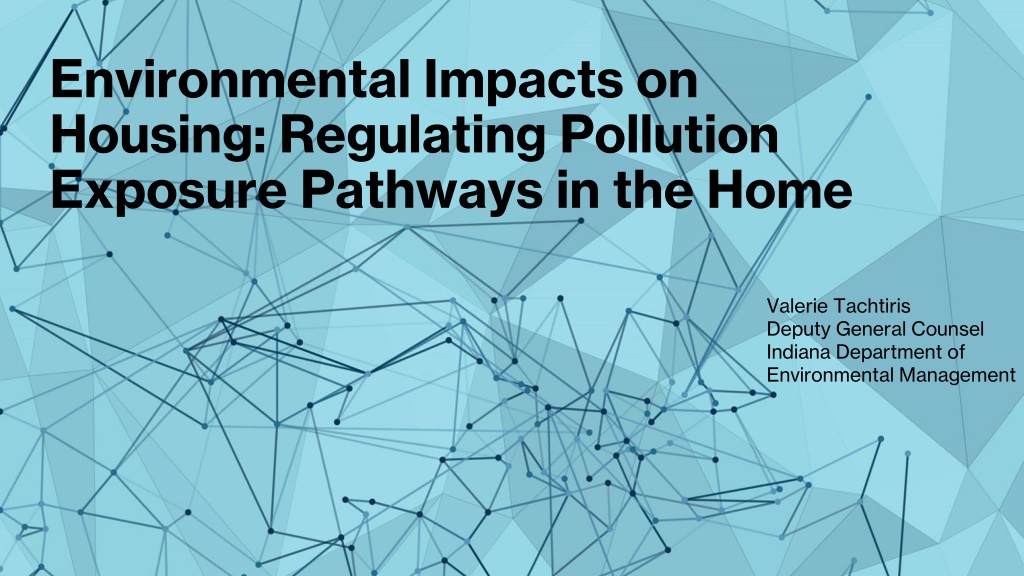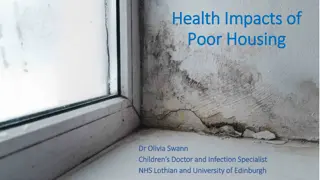Understanding Environmental Impacts on Housing: Regulating Pollution Exposure Pathways
Explore the regulatory framework for managing pollutant exposure in homes, highlighting the complexity of exposure pathways and the importance of assessing risks based on toxicity and exposure levels. The discussion covers various exposure pathways such as drinking water, air quality, dermal contact, and vapor intrusion, emphasizing the significance of evaluating pollutants like VOCs, lead, asbestos, and household chemicals. Understand the role of environmental statutes and regulations in ensuring testing, record-keeping, and reporting of chemical risks.
- Environmental impacts
- Housing pollution
- Exposure pathways
- Pollution regulation
- Environmental regulations
Download Presentation

Please find below an Image/Link to download the presentation.
The content on the website is provided AS IS for your information and personal use only. It may not be sold, licensed, or shared on other websites without obtaining consent from the author. Download presentation by click this link. If you encounter any issues during the download, it is possible that the publisher has removed the file from their server.
E N D
Presentation Transcript
Environmental Impacts on Housing: Regulating Pollution Exposure Pathways in the Home Valerie Tachtiris Deputy General Counsel Indiana Department of Environmental Management
Exposure pathways
Presence of a pollutant does not always mean exposure to that pollutant Environmental regulators often speak in terms of complete and incomplete exposure pathways
Complete Exposure pathways-EPA guidance 1. Source how the substance enter the environment 2. Media air, soil, and/or water 3. Exposure where receptors contact the media 4. Exposure Route how the substance enter the receptor s body (ingestion, inhalation, dermal) 5. Receptor which plants and/or animals are exposed or potentially exposed Source: https://www.epa.gov/ecobox/epa-ecobox-tools-exposure-pathways-exposure-pathways- era#:~:text=For%20an%20exposure%20pathway%20to,one%20or%20more%20exposure%20routes
Exposure pathways in the home Drinking water Air in the home Dermal contact Incidental ingestion
Vapor Intrusion Infiltration of vapor- forming chemicals into a building from the subsurface. Common pollutants: VOCs, PCE/TCE, PCBs, and benzene Are volatized and enter homes through soil, groundwater, and/or sewer and drainlines
Pollutants of concern in the home Remember: presence of a chemical does not (necessarily)create an exposure pathway Environmental risks are evaluated based on toxicity and exposure
Pollutants of concern in the home Household chemicals Lead paint and products Contaminants in drinking water Asbestos VOC and other air pollutants
Environmental Statutes and Regulations
Requires testing, record-keeping and reporting by chemical manufacturers. Environmental Regs Toxic Substances Control Act Directly addresses the production, importation, use, and disposal of specific chemicals including polychlorinated biphenyls (PCBs), asbestos, radon and lead-based paint. Excludes food, drugs, cosmetics, and pesticides.
Regulates public drinking water systems that supply water to at least 15 service connections or 25 people. Environmental Regs Safe Drinking Water Act EPA has set legal limits on over 90 contaminants based on health effects and technological feasibility. Sets water-testing schedules and methods that water providers must follow.
U.S. EPA and delegated states conduct and pursue remedial actions under the Comprehensive Environmental Response, Compensation, and Liability Act. CERCLA gives EPA and states broad authority to require remedial actions and/or recover their costs from parties determined to be responsible for the contamination, regardless of whether the activity was permitted/legal at the time. Environmental Regs CERCLA Common applications of CERCLA to environmental exposure in the home would be soil remediation, groundwater assessment and remediation or use limitation, and VI mitigation. EPA guidance requires remedial actions conducted under CERCLA to be evaluated every five years. In December 2012, EPA provided additional guidance to project managers on assessing VI risk as part of five-year reviews. http://semspub.epa.gov/src/document/HQ/176385
EPAs attempt to ban manufacture of most asbestos-containing products was overturned by the Fifth Circuit Court in 1991. Asbestos exposure typically occurs through the lungs and is most likely when asbestos containing material (ACB) is disturbed in demolition/home renovations. Federal air regulations require building owners to notify the appropriate state agency before conducting demolitions/projects that could disturb ACB. Environmental Regs Asbestos Removal and Licensing Regulations Residential buildings with four or fewer dwellings are exempt; however, contractors are subject to worker safety practices and proper disposal requirements. Contractors and workers must be licensed to ensure an understanding of applicable safety requirements.
Thank you! Contact: Valerie Tachtiris vtachtir@idem.gov























